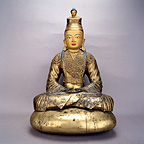
Item: King - Songtsen Gampo
| Origin Location | Tibet |
|---|---|
| Date Range | 1200 - 1299 |
| Lineages | Buddhist |
| Material | Copper |
| Collection | Private |
| Catalogue # | Potala Palace, Lhasa |
Classification: Person
Appearance: King
Gender: Male
Songtsen Gampo (reigned 617-650): the first Dharmaraja of Tibet. He married a Nepalese and a Chinese princess and was famous for building the Jokhang Temple of Lhasa which still stands today (2005).
Patron Kings: Songtsen Gampo
Part V in a series of discussions with Dzongsar Khyentse Rinpoche.
Songtsen Gampo is the forefather of Buddhism in Tibet. Two generations before King Trisong Detsen invited Shantarakshita and Padmasambhava to Tibet, King Songtsen Gampo cultivated the nation for its transformation, clearing pathways for the dharma to enter and ultimately permeate Tibetan culture. Without Songsten Gampo there would be no Tibetan alphabet, Lhasa would have no Jokang, and the supreme demoness of Central Tibet might still be roaming the earth unfettered.
Songtsen Gampo reigned from 617 to 650. His Yarlung dynasty was based in Central Tibet during an imperialist period in Tibetan history. Bon was the dominant religion, and Buddhism was only seminally present. No Tibetan translations of the Buddhist scriptures existed, partially because there was no written form of Tibetan, so Songsten Gampo instructed his minister Thonmi Sambota to travel to India, study Sanskrit, and develop a Tibetan script. He then commissioned the translation of several thousand texts.
His celebrated successes in battle expanded the Tibetan empire deep into Nepal and China, and it was during these battles that he gained an appreciation of the neighbouring cultures. As a reminder of the great empire that Songtsen Gampo ruled, a large pillar still stands before the Potala palace in Lhasa, erected during his reign, on which is inscribed the agreement between the Tibetan and Chinese rulers to respect each other's borders. He studied Chinese, became skilled in the art of leadership, and most importantly, he adopted sacred codes of conduct from Buddhist scripture. Under his rule, sacred practices began to replace the shamanistic practices of the Bonpos.
Songtsen Gampo's two queens can be credited for a great part of his cultural awareness. Bhirkuti, from Kathmandu, brought the traditions of Himalayan Buddhism. Princess Wengchin, daughter of the Tang emperor, brought a treasure trove of ancient Chinese wisdom. She travelled across the steppes to her husband with a collection of Chinese classic literature and texts on sacred astrology, geomancy, and medicine.
Many obstacles lay in Princess Wengchin's path as she headed to Yarlung. She had a vision of a gargantuan demoness who lay sprawled across the Himalayas, so large that one limb lay in Paro, Bhutan and another lay in Western Tibet. When she arrived in Yarlung, she shared her vision with her new husband. Recognizing the value of the treasures that his bride brought to him, as well as the importance of her vision, King Songsten Gampo commissioned thirteen demoness-subjugating temples across the land, built over the demoness's vital organs, ankles, wrists, and torso, forever binding her from wreaking havoc. The Lhasa Jokang was built over her heart centre, and Wengchin's Buddha statue was placed inside, where it still resides. Other such temples are Trenduk Lhakhang in Tsetang and Paro Kyichu in Bhutan.
King Songtsen Gampo is considered a human emanation of Avalokiteshvara, and he was the grandfather of King Trisong Detsen. Songtsen Gampo meditated for several years in a cave that is now at the core of Potala palace, and is revered for his great patronage of Buddhism.
Through his enlightened leadership, the path was cleared for the dharma to be propagated throughout the provinces, and for Buddhism to flourish.
Source: Khyentse Foundation
Exhibition: Tibet, Treasures from the Roof of the World
Thematic Sets
Collection of Tibet Museum, Lhasa
King: Songtsen Gampo (Tibet)


